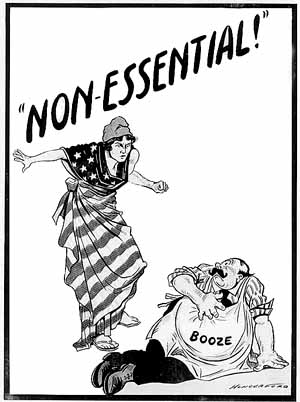In July 1914, construction commenced on Adolphus Busch Hall on the campus of Harvard University in Cambridge, MA. It could not have picked a worst moment to consummate years of enthusiastic planning. Shortly before, on June 28, a Serbian terrorist had assassinated the heir to the Austro-Hungarian throne, sparking a chain of events that led in August to World War I.
The first American museum devoted to the artwork of German-speaking Europe, underwritten with $265,000 ($6.3 million in today’s coinage) from the hall’s namesake, the co-founder of Anheuser-Busch, would have to wait. Though construction was finished in 1917, Harvard did not open the museum until 1921, three years after the war’s end. The official reason? Lack of coal to heat it. The real reason? Anti-German sentiment that sprang up almost immediately after the start of the war a century ago.
It seems callously crass to discuss a war that killed millions in terms of its effects on beer. Still, given that several of the greatest beer nations, including Germany, Belgium, Great Britain and the United States, were consumed in the conflagration, World War I affected beer, and brewers, in profound ways, including in ways that reverberate today.
Some seem faintly ridiculous with a hundred years’ hindsight. In a precursor to “Freedom fries” in our own lifetimes, French merchants relabeled bottles and kegs of pilsner, that grand Czech style, as “Biere de la Meuse,” after the river, the Czechs being one of the smorgasbord of nationalities that comprised the Austro-Hungarian Empire, a top ally of Germany, then at war with France.
In Great Britain, Prime Minister David Lloyd George, already a temperancehead when the war started, declared in March 1915, “We are fighting Germany, Austria and drink; and as far as I can see the greatest of these deadly foes is drink.” Such abstemiousness drove King George V the following month to pledge to avoid alcohol for the rest of the war; His Majesty called upon other nobles to join him, though only the Duke of Portland responded (a bit ironic, given the dukedom’s U.S. namesakes becoming such beer meccas a century later).
On a more poignant note, a few months before Lloyd George’s pronouncement, the Brits’ “deadly foes” served them beer during what became known as the Christmas Truce in 1914, when the two sides took a holiday break from the slaughter to mingle in the No Man’s Land between the trenches. From a British medical officer’s letter home: “Our men and the Germans got out of the trenches and met each other and chatted in great groups. The Germans in fact brought a barrel of beer over to the Regt on our left!”
Of course, it could not all be poignancy and absurdity. The barbarism of war seeped in as when the Germans routinely destroyed breweries on their march through Belgium in 1914, commandeering their copper and other metals for weaponry. Most famously, the Kaiser’s men destroyed the Trappist brewery at Hammont-Achel, smack on the Dutch border, careful to cart away materiel from only the monastery’s property actually in Belgium, leaving that in the neutral Netherlands untouched. (The monks would not start brewing again at Achel until 1998.)
At the same time, various Allied populations boycotted German products, beer chief among them. This led not only to declines in sales, but also to the sorts of side effects that included the delay in the opening of that first American museum dedicated to the art of German-speaking Europe and underwritten by Adolphus Busch, German beer baron.
Such boycotts had another, much more momentous side effect: Prohibition. Temperance activists in the United States picked up on Lloyd George’s histrionics over drink and soldiers, and drinking soldiers, and helped ride it to the Nineteenth Amendment enacted in 1920, less than two years after World War I ended. (In the United Kingdom and its Australian dominion, Lloyd George et al were able to enact earlier closing times for pubs; in Canada, also part of the British Empire then, the government enacted prohibition as well, though it petered out province by province after the war.)
While it’s true that American voters elected a “dry” Congress, and re-elected a very dry president in Woodrow Wilson, in 1916, the nation’s 1917 entry into World War I helped matters along greatly. Under Prohibition, the American brewing industry all but disappeared and took years to stagger back to health after Repeal in 1933. Those at the vanguard of the recovery? Americans of German descent.
Read more Acitelli on History posts.
Tom Acitelli is the author of The Audacity of Hops: The History of America’s Craft Beer Revolution. Reach him on Twitter @tomacitelli.

